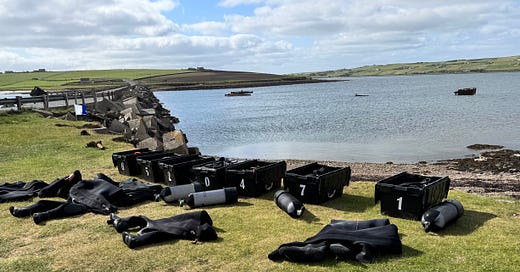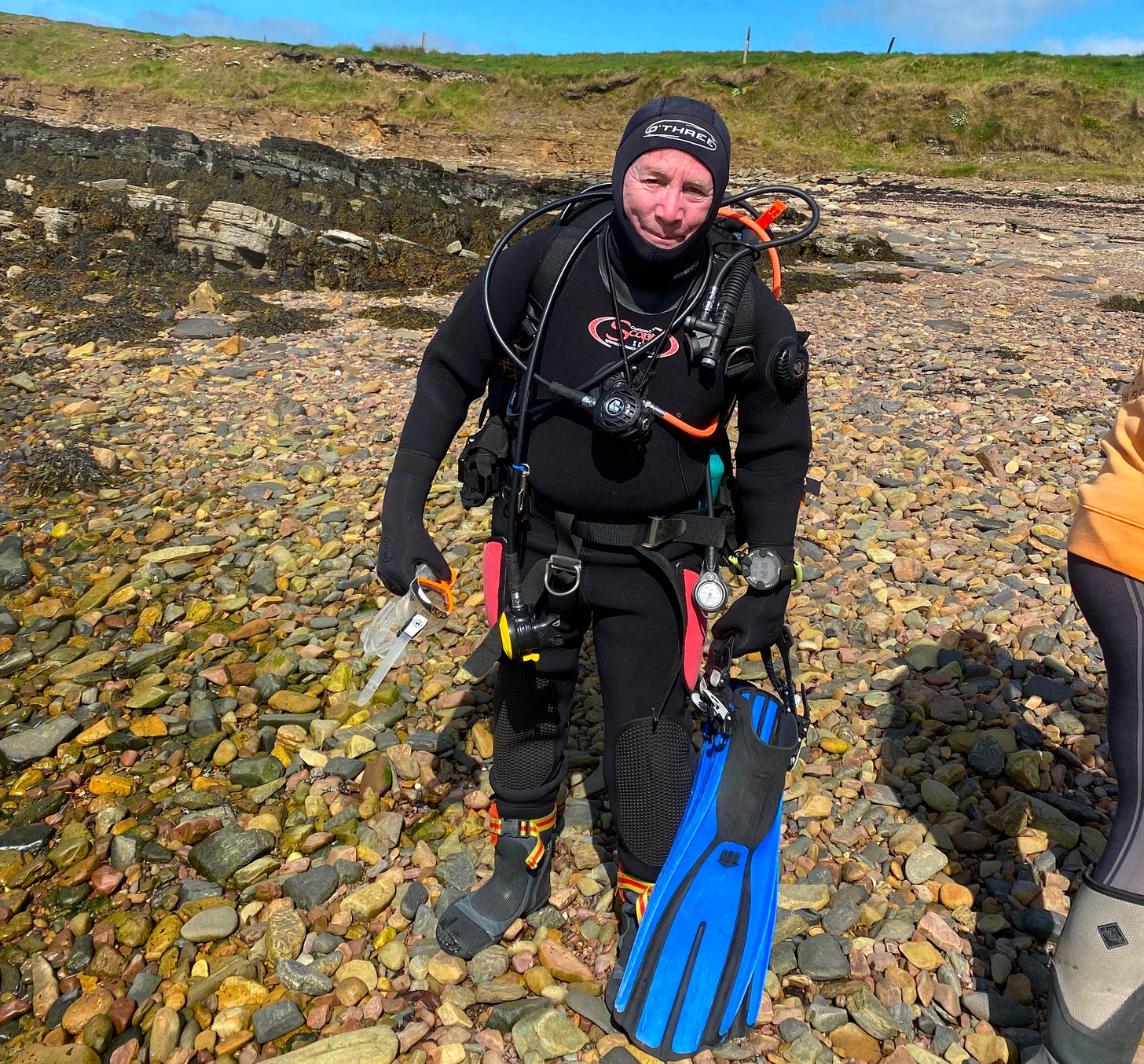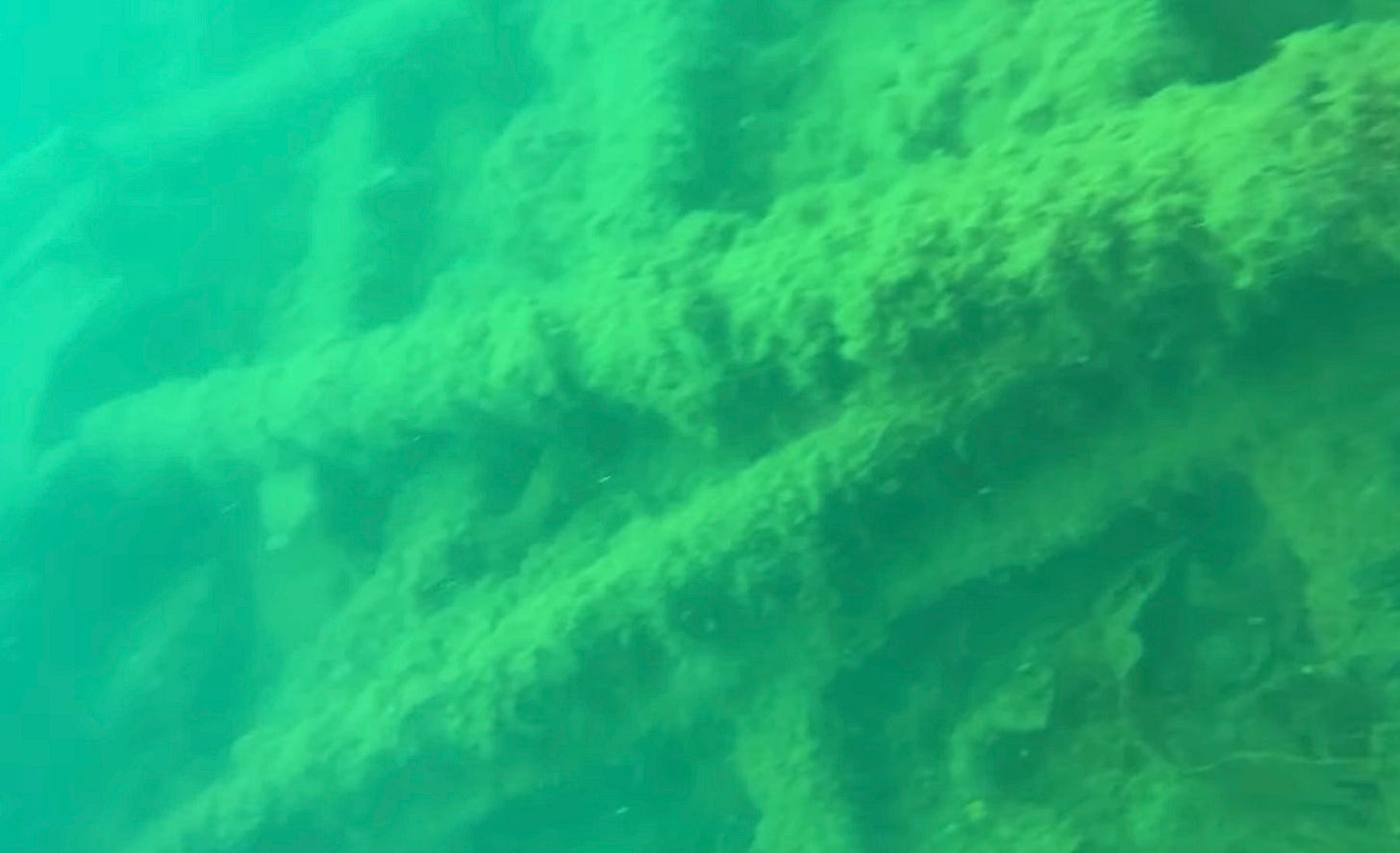How to age gracefully: don’t think you can do everything you did when you were younger.
A cold water scuba dive in Scapa Flow teaches me that it is time to take up snorkelling.
One of the things I really wanted to do when I came to Orkney on vacation was to scuba dive among the wrecks of Scapa Flow. I learned to dive in 1981 in the Hart House pool at the University of Toronto and was certified after an open-water dive in Midland Ontario, and have been an occasional diver ever since. There is so much history in the waters of Scapa; the German fleet was scuttled there in 1919 and it is one of the key bucket list items for divers.
Spouse Kelly was dubious- I had not dived in ten years and she wondered whether I was up to it at 72 years old. I was a bit nervous and talked to Margot and Rob at Kraken Diving, who suggested a shore dive to some wrecks no more than ten meters (thirty feet) deep, which anyone can do with snorkels, but I was here to scuba. I had also never been in a dry suit, which is an additional challenge, but they said they would show me how.
Nothing about this is easy. Just getting into a dry suit is exhausting. It is a quarter inch of neoprene with boots and patches of plastic for protection and weights to compensate for the suit’s buoyancy. You have to grease your wrists to get your hands through and you wonder if you will be able to breathe through the tightness around your neck. You are pulling and pushing and worn out before you even get near the water.
Then you add a weight belt, the tank, the buoyancy compensator backpack and tank, the two regulators you breathe through (one you use, one as backup.) There are even little weight belts around your ankles because if you are as short as I am, the neoprene is all bunched up there. The main regulator has a ridiculously long hose for reasons I didn’t quite understand, and this made me nervous; I was trained that if you ever run into trouble finding your regulator, you reach back behind your head and feel your way along the hose. I couldn’t do this with it snaking around my waist, so weird.
Then you stand up and have to walk thirty feet to the water and another twenty to where it is deep enough. This is hard on the rocky shore and this stuff is heavy. Seriously heavy. About two feet into the water I fell, and Rob had to drag me to where it was deep enough for him to put my giant flippers on.
A key piece of diving equipment is the buoyancy compensator. If you are swimming naked, you are pretty close to neutral buoyancy and can adjust just by the amount of air in your lungs; if you are scuba diving, you have to compensate for the buoyancy of the wet or dry suit, which compresses and loses buoyancy as you descend, so you have to add air to find your balance. A dry suit has a lot of neoprene, and I had a lot of trouble getting it right. The design of the valves on the compensator have not changed in 30 years, and they are terrible, not at all ergonomic; I was using it a lot and could never comfortably get a grip on the right button with my heavy gloves. Modern high-end buoyancy compensators wrap around your body and distribute the lift evenly; most have the lift on your back, and counterintuitively, I felt it kept trying to roll me over. I learned that you have to keep your head up instead of aiming down; all the air goes to the bottom of the compensator and the valve, getting its air from the top, becomes useless.
After about fifteen minutes I found my comfort zone. I was stable, breathing at a reasonable rate, and Rob guided me to the wreck with a hand on my back most of the time. (This was disconcerting at times, I was originally told to follow him but never saw him, he was always above me ensuring that I was OK)
We puddled around the wreckage of a First World War vintage commercial ship sunk to act as a blockship before the Churchill Barriers were built; what many people thought was a gun is in fact the propeller shaft. It’s all covered in plants and is definitely not the Titanic. But this is what I came for. The second dive would be to a Second World War wreck in much better shape, but about twice as far from shore.
I was surprised at how hard it was to move. I run and I row on water and land and consider myself fairly fit, but I would kick my flippers and it seemed that I wasn’t getting anywhere. I had to stop a few times because my calves cramped up and I couldn’t kick at all, and then would just work through it. Rob said after that he was trying to slow me down, that I was pushing too hard,going too fast, and exhausting myself, but I didn’t get that message and kept pushing.
Then I was down to about 100 PSI of air, and it was time to head back to shore. I am not sure, but I suspect that Rob was grabbing my tank and helping me along. Once we got to the shore I stood up and each hand was held by Rob and another Kraken instructor, and I was supposed to walk about 30 feet to a concrete block where I could sit and remove my gear, but I couldn’t make it; my legs were collapsing under me. I asked them to remove my tank and weights where I stood; I couldn’t go another foot.
I decided then and there that I wouldn’t do the second dive that was part of the package. I remembered George at the Hanlan Boat Club in Toronto where I rowed for years; He was in his eighties, and I offered to help him put his boat onto the rack. He said no; “the day I can’t put my boat away is the day I give up rowing.” I felt on that beach that the day I can’t get out of the water and walk ten feet with my gear on my back is the day I give up diving.
I have since reconsidered and am thinking now that maybe it is just the day I just give up cold water diving in a dry suit with God knows how much weight I was loaded down with, it is serious work. Five hours later I am still exhausted and my calves still ache.
I have been meditating on this all afternoon, dealing with the question: was I too to old to do this? I sent a note to Rob and Margot to explain that my bailing on the second dive had nothing to do with them and they responded:
“Definitely need to get some more cake in your system to bring back the energy levels! We are so glad you enjoyed this morning. Cold water diving is definitely a draining sport but if you do find you are back this way again, we'd love to have you back.”
I don’t think more cake would have cut it. I have hung up my snowboard for cross-country skis and I now ride an e-bike. If I am not going to go deeper than 30 feet then really, I should just enjoy snorkelling.
It’s not about giving things up, it is about evolving. I am going to have another sip of Scapa single malt and be proud that I showed up and did one dive and not be upset about bailing on the second; I learned something about myself, about accepting limitations.
A shoutout is due here to Kraken Diving. I had been emailing them for months- what do I wear? How deep do we go? They always responded instantly and often humorously. I found Rob a bit intimidating in person (he is two feet taller than me) but he was THERE, every second, ensuring that I was not just not dying on him but that I was upright, safe and comfortable, a steady hand on my back for the entire dive. You simply can’t put a price on that.







Wow! Really well done there, Lloyd!
I have dived there as well, it's really challenging diving. I got down to the German cruiser which was at about 36 m down which was probably about as far down as I wanted to get.
WhenI wasswimming around on its fore deck? I was wondering where the gun was when I succeeded in smacking my head on the end of one of the barrels! found it!
Again, really well done at 72 Lloyd very impressive. Take it easy and enjoy your scotch!
I sold the motorcycle when I started to realize that I wasn't feeling as confident as I used to be.
I believe it's important to be brave and try new things.
I equally believe it's important to respect your instincts and listen to your gut.
Fortunately, my carbon fibre Hudson rowing skull weighs not much more than 30 lbs. When I can't lift that over my head, I know it will definitely be time to put it away for good.
Thanks for sharing, Lloyd.